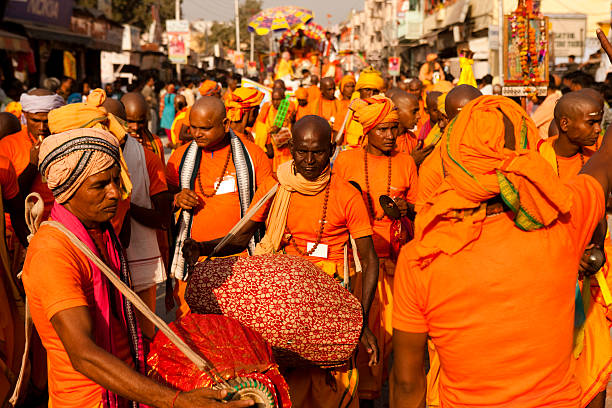Introduction
The Kumbh Mela is an event that showcases the rich fabric of Indian culture, spirituality, and communal peace in addition to being a religious gathering. Recognized as one of the world’s highest human gatherings, the Kumbh Mela attracts millions of pilgrims, visitors, and devotees from all over the world. This blog will look into the history, meaning, and experiences of the Kumbh Mela, offering lessons for both spiritual seekers and curious travelers.

What is Kumbh Mela?

The Puranas, an archive of ancient Hindu texts, are the source of the Kumbh Mela. The historical tale of Samudra Manthan is the source of the event. According to legend, gods and demons churned the oceans to get Amrit, the nectar of immortality. A fierce struggle broke out during this cosmic event, and drops of the priceless nectar fell in four locations on Earth: Ujjain, Prayagraj (Allahabad), Nashik, and Haridwar. Because it was believed that swimming in the sacred rivers during the festival would purify the spirit, these areas were hallowed during the Kumbh Mela.
Why Attend Kumbh Mela?

Regarding spirituality and faith, Hindus place great importance on the Kumbh Mela. It is considered a potent time for spiritual atonement and forgiveness. The festival’s high point is the Shahi Snan, or royal bath, where millions of yogis, sadhus, and pilgrims gather near the holy rivers in the hopes of being purified of their sins and granted moksha, or escape from the cycle of life and death.
Another fascinating cultural event that honors India’s many customs, rites, and spiritual practices is the Kumbh Mela. It promotes social interaction, cultural exchange, and religious discussion among diverse communities. The festival’s immense breadth and the dedication it generates show the participants’ continuous faith and solidarity, making Kumbh Mela a one-of-a-kind. The Kumbh Mela is a unique and important occasion in Indian spiritual history because of its enormous breadth and the devotion it inspires, which emphasize the participants’ unwavering faith and unity.
Location for Kumbh Mela
Four holy sites in India are the site of the Kumbh Mela; these sites have religious importance.
Prayagraj (Allahabad):
The rivers : Ganges, Yamuna, and the fabled Saraswati confluence
Important: Prayagraj, known for the Triveni Sangam, is the meeting site of three sacred rivers. Bathing at this confluence is thought to bring salvation and is regarded as extremely holy.
Haridwar :
The river : Ganges River
Important: In the Hindu faith, Haridwar is regarded as one of the seven sacred sites. This is the place where the Ganges River is said to have fallen from heaven, making it an ideal site for spiritual cleansing.
Nashik :
The river : Godavari River
Important: Nashik, a city in Maharashtra, is linked to numerous Hindu mythological occurrences, such as Lord Rama’s banishment. River Godavari is considered a river of purity.
Ujjain :
The river: Shipra River
Important: According to Hinduism, Ujjain is one of the seven holy towns. Ujjain is an important pilgrimage place because of the Shipra River and its mythological and historical connotations.
The Kumbh Mela Date : Best time to visit Kumbh Mela 2025
Astrological alignments decide the precise cycle that the Kumbh Mela follows.
Kumbh Melas come in four varieties, each with a unique frequency:
Maha Kumbh Mela :
Period: Once every twelve years
Location: Prayagraj (Allahabad), Haridwar, Nashik, and Ujjain.
Ardh Kumbh Mela :
Period: Every six years
Location: Prayagraj (Allahabad), Haridwar.
Kumbh Mela:
Period: Every three years, with a rotation between the four sites
Location: Haridwar, Prayagraj (Allahabad), Nashik, Ujjain.
Based on the Hindu lunar calendar and the locations of Jupiter, the Sun, and the Moon, the exact dates of the Kumbh Mela are known. An illustration of the schedule for the next Kumbh Melas is provided here:
Maha Kumbh Mela in Prayagraj, Uttar Pradesh, ( 13 Jan, 2025 – Wed, 26 Feb) 2025
Haridwar’s Ardh Kumbh Mela in 2027
Kumbh Mela at Nashik in 2030
As the festival draws near, it is advised to consult official announcements and municipal authorities for precise dates and comprehensive timetables.
Tips for Attending Kumbh Mela :
Plan To come : It’s important to reserve accommodation in advance due to the large amount of visitors. For convenience, think about accommodation close to the bathing ghats.
Remain Fresh : It’s important to stay hydrated throughout the Mela as it might be overpowering. To prevent upset stomachs, bring a reusable water bottle and use caution while eating food from the street.
Dress Modestly : It’s crucial to honor regional traditions. It is best to dress modestly, especially when taking part in ceremonies.Be Aware of Crowds : Be ready for sizable gatherings, particularly on popular bathing dates. Keeping an optimistic outlook will improve your experience.
Respect the ceremonies : Pay attention to the ceremonies and take part in them with deference. If you’re unclear about any particular customs, ask the locals.
Conclusion :


The Kumbh Mela stands as a powerful symbol of India’s spiritual essence, offering a unique blend of faith, culture, and humanity. It is not just a festival but a profound journey of self-discovery and communal unity. For those who witness or partake in this transformative event, the Kumbh Mela provides an opportunity to explore India’s rich traditions while embarking on a personal quest for spiritual enlightenment. Whether seeking cultural diversity or spiritual solace, the Kumbh Mela is a life-changing experience that deepens one’s understanding of the divine and the essence of humanity.
Custom Kumbh Mela 2025 Packages – Spiritual Journey with Comfort, Convenience, and Exclusive Experiences”
Kumbh Mela, covering its history, spiritual importance, rituals, and travel tips.




